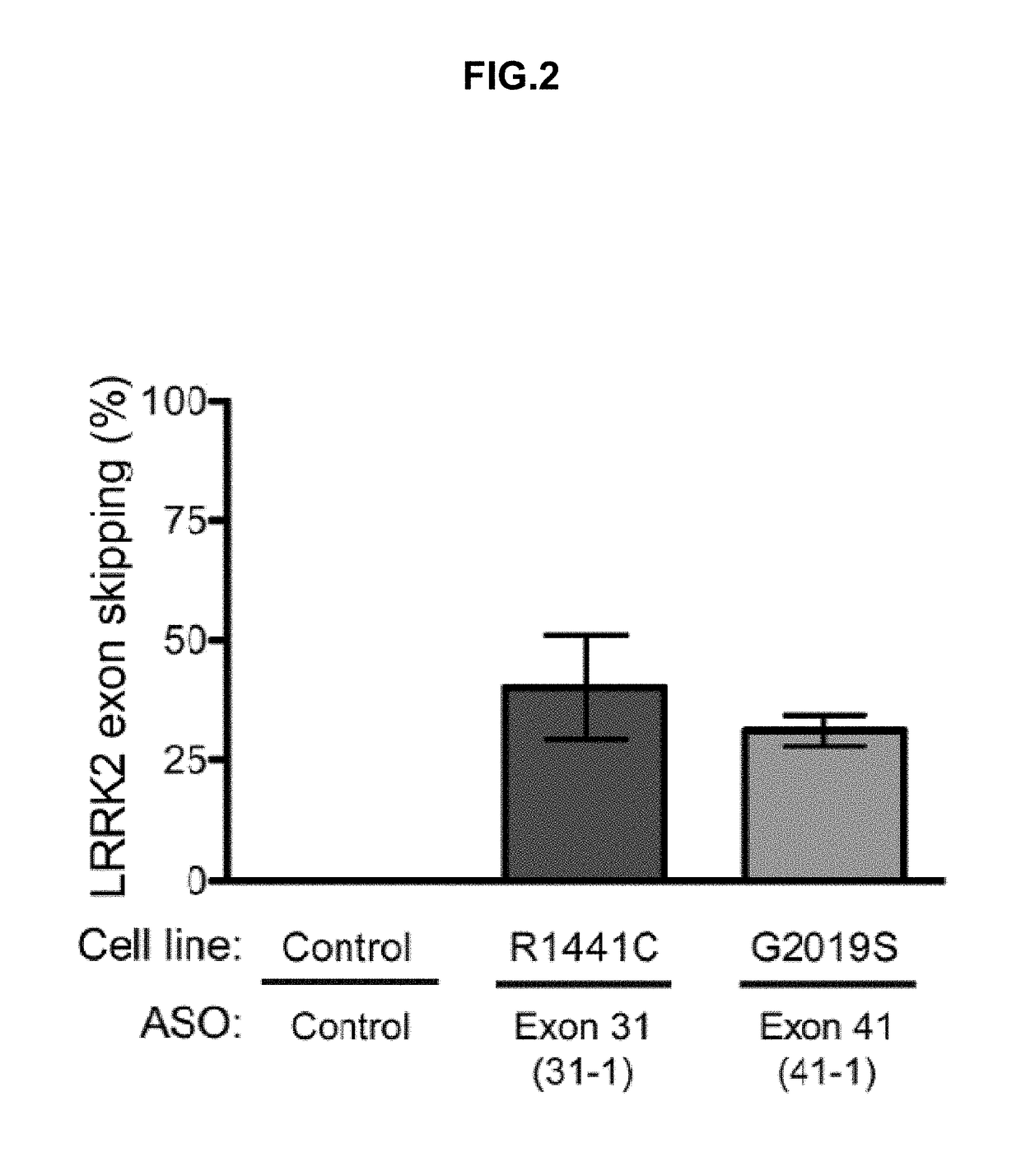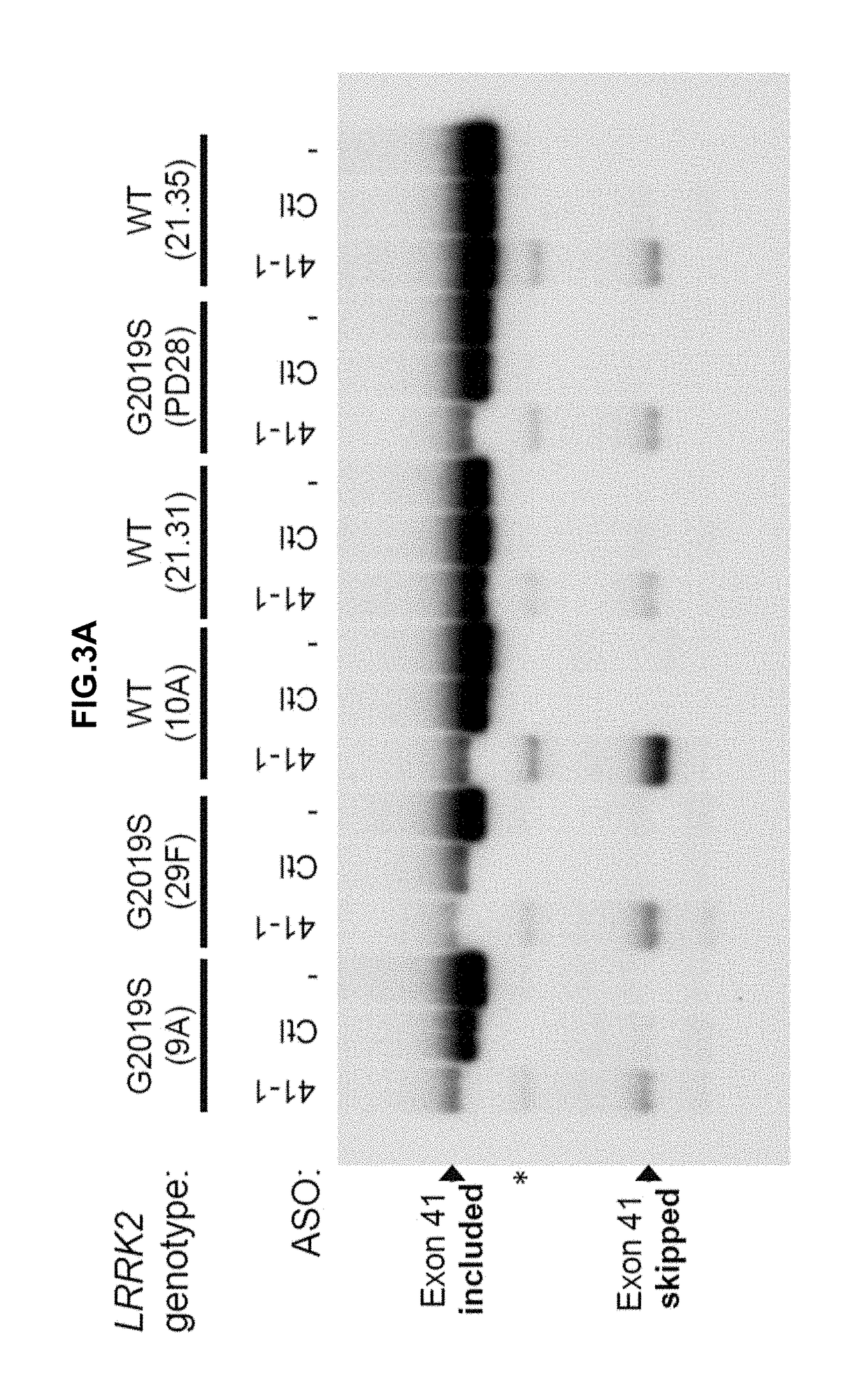Antisense compounds targeting leucine-rich repeat kinase 2 (LRRK2) for the treatment of parkinsons disease
a technology of leucine-rich repeat kinase and anti-lucinerich repeat kinase, which is applied in the direction of transferases, drug compositions, genetic material ingredients, etc., can solve the problems of not all symptoms responding equally, patients may have difficulty walking, talking, or completing other simple tasks, and may not be able to alleviate the symptoms at all
- Summary
- Abstract
- Description
- Claims
- Application Information
AI Technical Summary
Benefits of technology
Problems solved by technology
Method used
Image
Examples
example 1
Oligonucleotides Induce Skipping of Exon 41 in Human LRRK2 Gene in Human iPS-Derived Neurons
[0416]ASO 41-1 (see Table 3; SEQ ID NO: 2) was tested in the human iPS-derived neural cell line. ASO 41-1 (10 μM final concentration, one treatment at DIV41) was transfected into cells using Endo-Porter (GeneTools) according to manufacturer's protocol. FIGS. 3A and 3B demonstrate that ASO 41-1 induces skipping of targeted exon 41 of LRRK2 with or without the G2019S mutation.
[0417]ASO 41-1 and a non-sense control were tested in human iPS-derived neurons (AS041-1 is 5′-AGACAGACCTGATCACCTACCTGGT-3′; SEQ ID NO: 2) and a non-sense control oligonucleotide sequence (Non-sense control is 5′-CCTCTTACCTCAGTTACAATTTATA-3′; SEQ ID NO: 5) either once (5 days post differentiation, DIV37) or two times (2 and 5 days post end of the differentiation (DIV37 and DIV41)). Each time neurons were treated with 10 μM LRRK2 ASOs using Endo-Porter delivery method according to the manufacturer's protocol (Gene Tools, 4 ...
example 2
Oligonucleotides Successfully Reduce Full-Length LRRK2 Expression of LRRK2 Exon 31 and 41 in Fibroblast Cells from Parkinson's Patients
[0419]Various ASOs (see Table 4; SEQ ID NOs: 1 and 2) were tested in human fibroblast cells from one healthy subject control and two patients with Parkinson's disease one carrying the R1441C mutation and one carrying the G2019S mutation. ASOs (7.5 μM final concentration of either ASO 31-1 or ASO 41-1) were transfected into cells using Endo-Porter (GeneTools) according to manufacturer's protocol. FIG. 2 demonstrates that ASOs 31-1 and 41-1 induce skipping of targeted exons 31 and 41 in human LRRK2, respectively.
[0420]
TABLE 4 Antisense oligonucleotides targeting LRRK2induce exon skippingTarget%NameExonSequenceskipped *SEQ ID NO.31-131CTACCAGCCTACCATG40SEQ ID NO. 1TTACCTTGA41-141AGACAGACCTGATCAC31SEQ ID NO. 2CTACCTGGT* percent of the mRNA transcripts that skip out the targeted exon
[0421]The results provided in the examples and figures above demonstrate ...
PUM
| Property | Measurement | Unit |
|---|---|---|
| density | aaaaa | aaaaa |
| emission wavelength | aaaaa | aaaaa |
| length | aaaaa | aaaaa |
Abstract
Description
Claims
Application Information
 Login to View More
Login to View More - R&D
- Intellectual Property
- Life Sciences
- Materials
- Tech Scout
- Unparalleled Data Quality
- Higher Quality Content
- 60% Fewer Hallucinations
Browse by: Latest US Patents, China's latest patents, Technical Efficacy Thesaurus, Application Domain, Technology Topic, Popular Technical Reports.
© 2025 PatSnap. All rights reserved.Legal|Privacy policy|Modern Slavery Act Transparency Statement|Sitemap|About US| Contact US: help@patsnap.com



